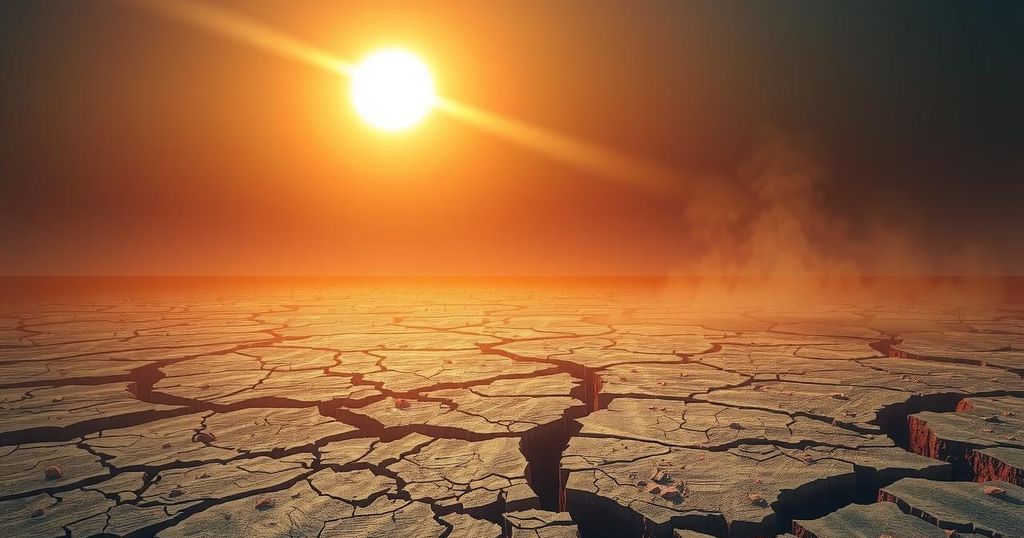A study reveals alarming projections of increased extreme heat impacting vast areas, equating to the size of the United States, if global warming reaches 2 °C. Vulnerable populations, particularly younger individuals and older adults, face severe health risks from heightened temperatures. Historical data from heatwaves illustrate the urgency of climate action to mitigate these threats, stressing adherence to international agreements to curtail warming.
Research highlights that if global warming reaches 2 °C, vast areas equivalent to the size of the United States could experience dangerous heat levels, even affecting younger individuals. Scientists reported an increasing number of heatwaves linked to climate change, raising concerns about human endurance limits. An alarming incident at the Hajj pilgrimage last year resulted in over 1,300 fatalities due to record temperatures of 51.8 °C (125 °F).
A study in “Nature Reviews Earth and Environment” explored the implications of extreme heat on human health. It documented a rise in unsafe temperature exposure, particularly impacting people in North Africa and South Asia. Findings showed that between 1994 and 2023, around 2% of global land area experienced hazardous heat for individuals under 60, while the vulnerability to older adults dramatically increased to approximately 20%.
Tom Matthews, the lead author, emphasized the grave consequences of a 2 °C temperature rise above pre-industrial levels. The Paris Climate Agreement aims to curb warming to “well below” 2 °C, acknowledging that the planet’s average temperature surpassed 1.5 °C last year. Without intervention, tripling of unsafe land area for younger adults and increased risk for seniors could occur, equating to a third of the planet’s total landmass facing peril.
The study warns about lethal heat exposure, defining potentially unsurvivable heat thresholds that could emerge under extreme warming conditions, thus endangering individuals even when sheltered. The body experiences heat stress when overwhelmed, causing severe health complications. Even lower temperatures become dangerous when humidity impairs sweat evaporation.
Europe has witnessed significant heatwave deaths, reporting over 70,000 in 2003, while Asia faces similar challenges with thousands of fatalities from heat events in countries like India and Pakistan. Chronic underreporting of heat-related deaths in Africa highlights further issues, exemplified by extreme conditions in Nigeria set for 2024. The WHO projects that heat fatalities number at least 500,000 annually, emphasizing that true statistics may exceed this figure substantially.
The issue of extreme heat and its impact on human health is becoming increasingly critical due to climate change. Rising global temperatures are projected to lead to more frequent and severe heatwaves, posing substantial risks to populations, particularly vulnerable groups. Past events have demonstrated the lethality of extreme heat, and studies are now exploring the anticipated changes in land exposure to unsafe temperatures as global warming progresses. The commitment established under the Paris Climate Agreement aims to mitigate these rising temperatures, underscoring the urgency to address climate change’s effects on human populations. As temperatures escalate, the findings surrounding dangerous heat levels are crucial for public health and environmental policy, indicating a pressing need for effective strategies to safeguard human well-being during extreme weather events.
This study underscores the urgent need to address climate change as rising global temperatures pose unprecedented risks to human health. The dramatic increase in areas experiencing extreme heat highlights the vulnerability of younger and older populations alike. With significant mortality rates already attributed to heatwaves, proactive measures are essential to mitigate these dangers and adhere to international climate agreements aimed at limiting global warming. The reality discussed in this study calls for immediate global action to protect vulnerable populations from the adverse effects of climate change.
Original Source: www.cp24.com






